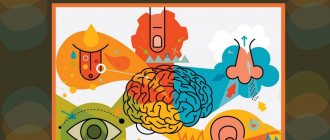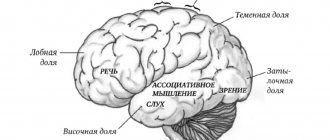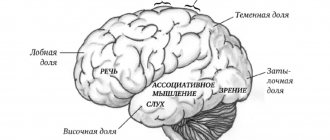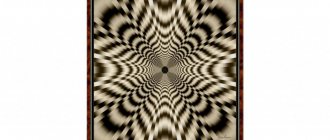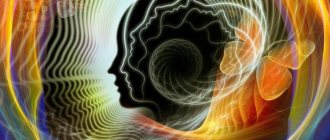In contact with external reality, a person carries out a cognitive process , which is divided into many elements.
This includes attention, memory, thinking, and many other mental phenomena. The most basic and primary of them are sensation and perception. They are interconnected , but represent completely different psychological processes.
These mental mechanisms give a person knowledge about the world . But there is a difference between them, which is influenced by quantitative and qualitative factors. Let's look at the similarities, differences and relationships between sensation and perception in the article.
Read about the mechanisms of space perception in psychology here.
Definition
Sensation is the primary stage of the sensorimotor response. And it is tightly connected with perception. Both phenomena act as intermediaries in the transmission of the environment, existing independently of consciousness, based on the impact on the senses: this unites them.
But in psychology, perception is not just a sensory image of an object or phenomenon, but also its awareness. It characterizes a diverse range of relationships that result in meaningful situations. Thus, perception can be safely called a form of knowledge of reality.
Formation of perception
The development of perception is inextricably linked with activity. When solving various problems, a person inevitably perceives his surroundings. And in this process a person can not only see, but also look or even peer, not only hear, but also listen, and perhaps listen. Thus, he performs certain actions aimed at correlating the image of perception with the object, which are necessary first for understanding the object itself, and then for its practical application.
This constitutes the most significant difference between perception and sensations: the ability not only to react to a sensory stimulus, but also to penetrate with consciousness into one or another quality belonging to a certain object. Therefore, this phenomenon provides for a fairly high development of not only sensory, but also motor functions.
Thus, using the example of an artist’s creative work, the connection between perception and activity is particularly clear: the artist’s contemplation of the surrounding space and the subsequent depiction in the picture are components of a single process.
Physiological basis
Sensation is the source of the psychological process.
This is something that everyone has: mammals, some simple organisms, and, of course, humans.
receptors take part in their appearance . Without receptors, these experiences would not be available to humans or animals.
Receptors can be divided into two categories : those that deliver signals from the outside world, and those that analyze information coming from within. Internal information can manifest itself in feelings of pain, hunger or thirst.
Sensation as the basis of perception
Any perception goes through an introductory stage of object recognition, which is based on sensory indicators of sensations transmitted by the senses. And they, in turn, react to external stimuli. This makes both phenomena related to each other.
But perception is not just a set of sensations. It is a rather complex integral process, qualitatively different from those initial feelings that form its basis. In addition, it includes accumulated experience, the thinking of the perceiver, as well as emotions.
Thus, in psychology, perception is the unity of the sensory and semantic, sensation and thinking. But at the same time, the mind relies on the impression, using it as a starting point for its further development.
Why and how to train sensations?
If you train your senses, you will significantly improve your memory. As you may know, the information that is best remembered is that associated with the senses: for example, English words need to be written, made vivid, maybe even “sniffed.” And memory, in turn, is closely related to creative thinking. In short, by consciously sensing, you develop many cognitive skills.
There is one simple but very effective exercise. The essence of it is to devote five minutes to training one of the senses:
- Vision: Pay attention exclusively to what you see. Look at the object, its shape, curves, highlights.
- Smell: Open the refrigerator, take out foods one by one and smell them. It is best to do this, of course, alone. Try to compare smells and analyze them. Let us remind you once again: try to turn off all other senses.
- Hearing: Begin to pick up all the sounds you hear. Compare them, try to switch from one to another.
- Touch: touch different objects - paper, table, blanket. Try to understand the difference in sensations, stay in this moment.
- Taste: Try different foods (little by little). Don't swallow it right away, try to understand all the flavors. Compare varieties of cheese, bread or meat.
You may ask: “Why doesn’t sensory training occur in everyday life?” The thing is that we don't do it consciously. The sensations only occur if you pay attention to them. Everything else seems to fall on deaf ears.
Characteristics of sensations
To better understand what is the foundation of perception as a mental phenomenon, it is necessary to turn to the nature of the sensations themselves, which are dependent on external stimuli and, reflecting their individual features, have a number of certain properties:
- One of the main characteristics is the quality threshold. For example, for visual sensations - color contrast, for auditory sensations - voice timbre, etc.
- The quantitative threshold, or intensity, is determined by the strength of the stimulus and the state of the receptor itself.
- Spatial localization - correlation with a specific part of the body that is exposed to the stimulus.
- Adaptation is the adaptation of the senses to the influencing stimulus. For example, adaptation to some smell that is constantly surrounding.
Properties of perception
Unlike sensations, perception reflects the totality of all properties of an object, i.e., considering it as a whole, without splitting it into parts. And at the same time it has a number of its own specific features:
- Integrity is the recognition of a whole object by its individual parts, the ability to perceive the whole picture. For example, seeing a trunk, a person completes the image of an elephant in his mind.
- Constancy - lies in the constancy of shape, size, color under varying conditions of their perception, in the relationship between objective reality and a certain object in it.
- Objectivity is the recognition not of a set of sensations, but of an object itself that has a specific function.
- Meaningfulness - awareness of the meaning of the subject, inclusion of the process of thinking, analysis and evaluation.
Thus, the properties of perception and the properties of sensation, on the one hand, are heterogeneous in nature, and on the other, without accepting the basis built from individual characteristics, the formation of such a mental phenomenon as perception is impossible. This whole consists of transformed parts, passed through the prism of awareness and experience.
Sensation and perception
Every day we experience a huge number of sensations: we smell, distinguish colors, temperature, brightness of light and much more. What is this feature of our body and how does the brain function? How is sensation different from perception? And why do you need to know all this? In this article we will answer these questions.
Classification of sensations
Since sensations are generated by a specific physical stimulus, they are divided according to the level and modality of impact on various receptors:
- Organic - associated with organic needs: thirst and hunger, breathing, etc. Sensations of this kind, as a rule, have a relatively strong emotional intensity and are often unconscious. Thus, diseases are associated not only with pain, but also with an emotional state: heart problems with a lack of joy, love, fears; liver problems - with irritability and anger.
- Static - indications about the state of the body in space, active and passive movements, as well as movements of individual parts of the body relative to each other.
- Kinesthetic - caused by stimulation emanating from receptors located in joints and muscles. Kinesthesia is closely related to vision: hand-eye coordination plays an important role in movements carried out under the control of vision.
- Skin – pain, temperature, touch, pressure.
- Tactile - unlike touch, are active in nature, since there is a deliberate feeling of an object associated with an impact on it. With touch, knowledge of the world occurs in the process of movement.
- Olfactory and gustatory are of particular importance in the formation of an emotional environment that causes pleasant or unpleasant sensations in a person.
- Auditory - are dual in nature, in other words, a person perceives sound with both ears. Thus, people who are deaf in one ear find it difficult to determine the source and direction of sound.
- Visual - any color has an effect on a person, which is due not only to the physiological effect on the body, but also to the associations of the person himself. Some colors are capable of stimulating the nervous system, others are capable of inducing a trance, etc. For example, blue is usually associated with blue sky, orange with fire, etc.
LiveInternetLiveInternet
Saturday, July 13, 2013 01:08 + in the quotation book
Topic 4-5. Sensation and perception There is nothing in consciousness that was not previously in sensation.
Ernst Heine Has it ever occurred to you to count the entire stock of knowledge about objects, phenomena, i.e.
about everything that surrounds you? Even if someone willing to do so was found and did the calculations, he would be surprised that the stock of knowledge is so huge. How do we gain knowledge about the world around us?
A person receives the very first knowledge about the world around us with the help of special mental processes - sensations and perceptions.
Sensations and perceptions are the main provider of knowledge. Thanks to them, a person distinguishes objects and phenomena by color, smell, taste, temperature, smoothness, size, volume and other characteristics. Sensations and perceptions underlie more complex mental processes - thinking, memory, imagination. Thanks to accumulated ideas obtained through sensations and perceptions, we learn to adapt and navigate the world around us. Let's take one of the simplest examples. If we are lightly dressed and get caught in the rain without an umbrella, we return home in wet clothes, dirty, and cold. The lesson is not in vain - we remember our unpleasant feelings. The next time we are going to leave the house, we listen to the weather forecast and not only take an umbrella, but also put on a raincoat or jacket and appropriate shoes. Sensations and perceptions are similar, but there are significant differences between them. ^What are sensations?
Sensations arise from direct contact with an object.
So, for example, we learn about the taste of an apple that we were treated to when we try it. It looks red and beautiful, but when you bite into it, it may turn out to be sour. How did our favorite variety of apples come about? We tried different varieties, our feelings summed up - this apple is sweet for some, sweet and sour for others, sour for others - I like it. However, there are people who love all apples. ^ Sensation is a mental process that occurs in a person when the sense organs are exposed to objects and phenomena, which consists in reflecting (cognition)
the individual properties of these objects and phenomena. Underline the word “separate”.
All surrounding objects have many properties. Touch the desk. What do you feel? By touching, we gain knowledge not about the entire desk, but only about its individual properties - it is hard, dry, rough. Now look at the desk. What is she like? Through vision we can say that the desk is of a certain color, shape (gray, dirty, written on, rectangular, etc.). Knock on the desk. How do you feel? Through hearing we determine that the desk is wooden and makes a dull sound. All these are examples of individual sensations through which we experience the world around us. Remember: through sensations we receive information not about the entire object, but only about its individual properties. ^ Mechanisms of sensations.
To make it even clearer what sensations are, let’s consider how this process occurs.
Have you heard of the concept “ analyzers
”?
This is a complex nervous mechanism that produces a subtle analysis of the surrounding world, i.e.
highlights its individual elements and properties. Each analyzer is designed to isolate and analyze certain information.
The most famous analyzers in humans are: visual, auditory, gustatory, olfactory, tactile - according to the five basic senses. Each analyzer has a specific structure: 1) receptors
- sensory organs (eye, ear, tongue, nose, skin, muscles);
2) conductor
- nerve fibers from receptors to the brain;
3) central sections
in the cerebral cortex.
How does the sensation happen? For example, we touched the desk. The receptors on the skin of the fingers received a signal, they transmit it through conductors to the cerebral cortex, where complex processing of the received information takes place (the sensation actually occurs) and the person receives the knowledge that the table is cold, rough, etc. Or a hot iron... In the cerebral cortex, information is processed and an instant conclusion is made: it’s hot and painful. Immediately there is a reverse signal: withdraw your hand. All analyzer departments work as a single unit. If one department is damaged, there is no sensation. For example, people born blind will never know the sensation of color. We experience the world around us and communicate with each other using our senses: eyes, ears, nose, skin, tongue. Through these organs, information enters the brain, and we know where we are, what is happening around us, etc. Think about how a person hears sounds? “I hear with my ears!” - you say, but this is an incomplete answer. A person hears with the help of the hearing organ, which is complex. The ear is only part of it. The auricle, or outer ear, is a funnel through which a person catches air vibrations. After passing through the auditory canal, they affect the eardrum. The vibrations of the membrane are transmitted to the auditory ossicles and reach the inner ear. Further along the nerves, the impulses reach the auditory center located in the cerebral cortex. Only with its help can we recognize sound signals. This is how sensations arise. It is not without reason that the definition notes that sensations arise when surrounding objects and phenomena influence the analyzers (sense organs). ^ Types of sensations.
The sensations, as you already understand, are different.
The main sensations associated with the five human senses are identified. 1. Visual sensations
.
Through them, a healthy person receives about 80% of information about the world around him - sensations of color and light
.
What, thanks to visual sensations, can we say about the world around us?
Visual sensations help to navigate in space.
Colors affect people differently. ^ Red
– excites, activates;
Orange
– cheerful and cheerful, sociable;
Yellow
– warm, invigorating, flirtatious, crafty;
^ Green
– calm, cozy mood;
Blue
- calm, serious, sad, invigorates mental work; if there is a lot of it, it causes coldness;
Purple
is mysterious, a combination of red and blue: attracts and repels, excites and sad.
2. Auditory sensations.
They occupy the second place in importance in a healthy person.
The main purpose for humans is speech recognition and other sound signals
.
Speech, music and noise sensations are distinguished. Loud noise has a negative impact on a person (on mental activity and the cardiovascular system). Why do we need two ears? Maybe one would be enough? Two ears allow you to determine the direction of the sound source. If you close one ear, you will have to turn your head in all directions to determine where the sound is coming from. The importance of hearing in a person’s life is very great. With the help of hearing, people receive information and communicate with each other. The child hears the speech of adults, and at first simply recognizes the sounds, and then begins to imitate them. Little by little he learns to pronounce individual sounds and words, and then masters speech. Rear 1.
Using a simple experiment, check who has better hearing.
To do this, you need to sit sideways to each other at a distance of about one and a half meters and close your eyes. The presenter brings his watch closer to you and away from you in turn. When you hear ticking, you say, “I hear it.” Having stopped hearing, “I don’t hear.” 3. Taste sensations.
The human tongue has taste buds that are responsible for
four taste sensations
.
The tip of the tongue recognizes sweet sensations, the back surface of the tongue recognizes bitter sensations, and the sides of the tongue recognize salty and sour sensations. As a person becomes full, the role of taste sensations increases, but a hungry person will eat less tasty food. Food consists of different components and evokes complex taste sensations. When we eat, we feel heat, cold, and sometimes headaches due to changes in atmospheric pressure, all of which affect the taste of food. In addition, taste sensations are not perceived in their pure form; they are associated with olfactory sensations. Often what we think of as “taste” is actually smell. For example, coffee, tea, tobacco, lemons stimulate the organ of smell more than the organ of taste. 4. Olfactory sensations.
Responsible for
recognizing odors.
In modern man, they play a minor role in understanding the world, but they influence the emotional background and well-being of a person.
When vision and hearing are affected, the olfactory sensations become important. Many animals, such as dogs, live solely by smell. In our nose, the membrane of sensory cells responsible for the sense of smell occupies an area about the size of a fingernail on both sides. In a dog, if you straighten it, it will cover more than half of its body. A person’s weak sense of smell is compensated by the higher development of other senses. By the way, when we simply breathe, the stream of air passes the membrane, and therefore we have to sniff - pass air over the membrane in order to smell it. There are five main types of smell that we can detect: 1. floral; 2. spicy (lemon, apple), 3. putrid (rotten eggs, cheese), 4. burnt (coffee, cocoa), 5. ethereal (alcohol, camphor). Why does a person need taste and smell sensations? 5. Tactile sensations - a combination of skin and motor sensations when feeling objects.
With their help, a small child learns about the world.
For people without vision, this is one of the important means of orientation and cognition. For example, when reading, Braille is used. Deaf people, in order to understand what the interlocutor is saying to them, can recognize speech by the movement of the vocal cords (by placing the back of the hand on the speaker's neck). Deaf-blind Elena Keller was able to fully exist in society through the tactile-motor learning system. She received an education, graduated from college, defended her dissertation, and held a government position in the employment of people with disabilities. The sense of touch is associated with sensations of temperature, pain, pressure, humidity, etc. These are the main types of sensations. ^ Others are also highlighted. 6. Organic – sensations of hunger, thirst, satiety, suffocation, abdominal pain, etc.
Receptors for these sensations are located in the corresponding walls of the internal organs: esophagus, stomach, intestines.
Everyone knows the feeling of hunger. But how do we know when we feel hungry? Hunger has nothing to do with an empty stomach, as many people think. After all, patients often, despite the lack of food in the stomach, do not want to eat. Hunger occurs when there is a lack of certain nutrients in the blood. Then a signal is sent to the “hunger center” located in the brain - the work of the stomach and intestines is activated. This is why a hungry person often hears his stomach growling. How long can you go without food? It depends on the individual. A very calm person may not eat for longer, since protein reserves in his body are consumed more slowly than those of an easily excitable person. The world record for the duration of fasting was claimed by a woman in South Africa, who, according to her, lived only on water for 102 days! ^ 7. Kinesthetic (motor) sensations - sensations of movement and position of body parts
.
Do a little experiment. Close your eyes and stand in some position: follow the command “at attention”, and then take the same position again. Think about which of the five senses helped you repeat the movement? It was a motor sensation caused
by irritation of receptors located in muscles, ligaments, and joints.
When walking, dancing, cycling, we feel a change in the speed or direction of our movement thanks to the vestibular apparatus of the inner ear. 8 ^.
Vibration sensations - occur when the surface of the body is exposed to air vibrations produced by moving or oscillating bodies. They play an important role in the deaf and blind.
With the help of these sensations, deaf-blind people learn about the approach of a vehicle or a person, touching the lips of a speaking person and feeling their vibration, they can learn the alphabet and then speak. are distinguished separately .
There is evidence that a person, using ordinary senses, can perceive stimuli that are beyond the lower threshold of his sensitivity, i.e.
a person reacts not only to those signals that he is aware of, but also to those that he is not aware of. Premonition and foresight are built on this. ^ Examples from life: 1. Pshonik conducted an experiment with his daughter in 1952. In the kitchen during breakfast, the daughter kept her finger on the button to which the current was connected. When the light came on, the current flowed, you had to have time to take your finger off the button. Over time, the girl, without the light bulb, withdrew her finger, reacting to subthreshold sensations. Together with the light bulb, Pshonik turned on a generator of high-frequency sounds that were not audible to the ear, the girl reacted to these sounds. 2. “25th frame.” The human eye consciously perceives 24 frames per second, and the video is based on this. An experiment was conducted: while watching a film in a cinema, the 25th frame with an advertisement was turned on: “Buy suspenders.” The human eye cannot consciously read this inscription, but the picture of the frame leaves an image on the retina. None of the viewers will say that they saw this inscription, but 15-20% of the viewers went to buy suspenders. This technique is prohibited. ^ The importance of developing sensations.
What happens if a person is deprived of many sensations from birth?
This person will develop more slowly and worse.
It is not for nothing that blind children begin to walk and talk later. Sensations are formed and developed as a result of practical actions and exercises. Therefore , it is necessary that the child receives the maximum number of different sensations
(through games, toys, communication).
Mowgli children are examples of the importance of early child development. So, in 1825, a young man of about twenty-two years old was found in a German city. He avoided people, bumped into objects, and did not respond to speech. Gradually he learned to speak and said that he lived in a cellar and remembered hands that sometimes appeared and gave bread and water. Once a week I woke up feeling washed and wearing new underwear. Then they took him to the outskirts and left him. There are people who see only two colors or see 40 colors. Why does this difference depend? From human experience. For example, 5 thousand years ago The Egyptians saw only 6 colors. This was explained by the peculiarity of the colors of the landscape where they lived. ^ The sensations depend on the exercises.
Every person has an innate ability to sense. Over the course of life, sensations transform and become more diverse. But for this they need to be developed. To make sensations more perfect, it is necessary to specifically exercise the senses. Many professions require subtle sensations and, in turn, contribute to their development. For example, artists, musicians, dancers, foreign language teachers, and musical instrument tuners have significantly higher sensations than other people. The blind have excellent hearing, the deaf have excellent vision. The Germans often blinded their hunting dogs in one eye and one ear, which increased their sense of smell and vision. This means that sensations can and should be improved.
Task 2.
We can check your tactile threshold for differences in sensations, i.e.
the minimal difference between two stimuli that produces a noticeable difference in sensation. Work is carried out in pairs. Take a paperclip and straighten it. One of you closes your eyes and extends your hand, the other places the two sharp legs of a paper clip on the back of your hand. At first, the distance between the legs is about 6 cm, gradually reduce this distance until the participant has the sensation of one touch (although the two ends of the paper clip are still touching). Measure the distance between the ends of the paperclip. This is your tactile sensitivity threshold. The lower this indicator, the higher the tactile sensitivity. ^What is perception?
The second mental process, which is responsible for our primary knowledge of the world around us and is closely related to sensation, is perception.
^ Perception is a mental process that occurs in a person when the sense organs are exposed to objects and phenomena, which consists in a
holistic reflection (cognition) of these objects and phenomena. Underline the word “whole”.
As you already understand, sensations allow you to reflect and perceive only individual properties of objects: colors, shape, size, smoothness, sounds, temperature, etc. But we will not receive objects through sensations of a complete image. So, if you describe a lemon through sensations, it will be something yellow, sour, oblong, rough and nothing more. Perception allows us to “see” the holistic image of an object. During perception, the individual properties of objects are combined into a single image. We see objects not only with our eyes, but also with our minds. Information about the world around us gradually accumulates in the brain - we have experience that is involved in the process of perception. ^ Perception is based on a person’s sensations and past experiences.
Look at the notebook and describe it.
How will you create her image? From sensations of color, shape, volume, roughness. Why are you sure that this is a notebook and not a ball or a shirt? Only thanks to past experience. When perceiving familiar objects, recognition occurs immediately; a person only needs to combine 2-3 signs. For example, you have geranium at home, you know what it looks like. When you come to visit someone and see the same geranium, you will recognize it instantly. And you see the plant standing next to it for the first time and wonder what it’s called. ^ Types of perceptions.
According to the action of the predominant analyzer, there are visual, auditory, olfactory, gustatory, and tactile perceptions.
There are also more complex types of perception that arise as a result of the work of several analyzers. 1. Perception of objects.
All types of sensations operate in the perception of objects.
When we see an orange, we combine visual, gustatory, olfactory and tactile impressions. The perception of individual objects is a very complex process. We identify the main features of an object, discard the unimportant ones, and then recognition of the object occurs. When perceiving familiar objects, recognition occurs quickly. Every time we perceive, we form a visual image of an object. We call this object a word. Therefore, perception is closely related to speech. When we perceive an unfamiliar object, we try to establish its similarity to a familiar one. For example, perceiving a watch and mentally calling it with this word, we are distracted from such unimportant features as the material from which the case is made, size, shape and highlight the main feature - the indication of time. Does everything that surrounds a person fall into his field of perception? How does the choice of an object of perception occur? 2. Perception of space,
i.e.
the distance of objects from us and from each other, their shape and size
.
These perceptions are built on the basis of a combination of visual, auditory, skin and motor sensations. Only accumulated experience gives us a correct idea of the size of objects. A person standing in a boat far from the shore appears much smaller than a person standing on the shore. But no one will say that one person is big and the other is small. We say: one person is close and the other is far from us. By the strength of the sound of thunder, we determine the distance separating us from an approaching thunderstorm; using touch with our eyes closed, we can determine the shape of an object. Through the experience of perceptions, we form an idea of perspective. When we look at the rails going into the distance, we see that they converge on the horizon line. Our eyes see this, and our brains, therefore, our experience suggests that they do not converge anywhere. The children have no experience yet, they think that the rails converge, so they ask: what is there? 3. Perception of time.
There is
a reflection of the duration and sequence of events
occurring in the world.
This is a very subjective process. The perception of the duration of time depends on what fills that time. Time periods filled with something pleasant are perceived as shorter. So it feels like a change always flies by instantly, and a boring lesson lasts a very long time. Depends on age: children perceive time as dragging on for a long time, while for adults, days and months fly by very quickly. Why is it that when we feel good, time is perceived as passing quickly, and when we feel bad or bored – as dragging slowly?
There are people who always know what time it is.
Such people have a well-developed sense of time. The sense of time is not innate, it develops as a result of accumulated experience. Task 3
.
Check who has a well-developed sense of time. Periodically, without looking at the clock, say what time it is; the one who guessed correctly more often (or was closer to the correct time) has an excellent sense of time. 4. Perception of movement.
There is
a reflection of changes in the spatial relationships of the environment and the observer himself
.
It involves visual, auditory, muscle and other sensations. If an object moves in space, then we perceive its movement due to the fact that it leaves our field of best vision and forces us to move our eyes or head. If objects move towards us and we try to focus our gaze on them, our eyes converge at one point and the eye muscles tense. Thanks to this tension, we form the idea of distance. By internal sensations we perceive the movements of our own body. Perceiving the world, a person highlights something in it, but does not notice something at all. For example, during a lesson you can enthusiastically watch what is happening outside the window and absolutely not notice what the teacher is saying there. What a person highlights is the object
of perception, and everything else is
the background
.
Sometimes they can change places. Task 4
.
Look at the image of the young woman half turned away. Can you immediately notice an old woman with a big nose and chin hidden in her collar? The individual uniqueness of perception depends on the mental state of a person at the moment. If he is cheerful, cheerful, joyfully excited, then one perception, if he is scared, sad, angry, then a completely different one. Therefore, the perception of the same person, event, phenomenon by different people is so different. Thus, each perception includes not only sensations, but also a person’s past experience, his thoughts, emotions, i.e. Every perception is influenced by a person’s personality. ^ Illusions of perception.
Sometimes our senses and our perceptions let us down, as if deceiving us.
Such “deceptions” of the senses are called illusions.
| ^Which square is larger? |
Vision is more susceptible to illusions than other senses. No wonder they say: “don’t believe your eyes”, “optical illusion”. Light objects against a dark background appear enlarged compared to their actual size. A dark object appears smaller than a light one of the same size. These illusions are explained by the fact that each light outline of an object is surrounded by a light border on the retina. It increases the size of the image. In general, all light objects seem larger to us than dark ones.
People appear thinner in a dark dress than in a light one.
| ^Which of the horizontal segments is longer? |
| ^ Which lines are longer? |
When comparing two figures, one of which is smaller than the other, we mistakenly perceive all parts of the smaller figure as smaller, and all parts of the larger figure as larger. This is clearly visible in the figure: the upper segment in it seems longer than the lower one, although in fact they are equal. Look at the picture, which shows lines - horizontal and vertical. Which ones are longer? You will say that the vertical ones are longer. This is a visual error. Lines of equal length. The horizontal ones are divided in half by the vertical ones and therefore seem to be shorter. Artists, architects, and tailors are well aware of visual illusions. They use them in their work. For example, a tailor sews a dress from striped fabric. If he arranges the fabric so that the stripes are horizontal, then the woman in this dress will appear taller. And if you “lay” the stripes horizontally, the wearer of the dress will appear shorter and thicker. Upside-down is a type of optical illusion when the nature of the perceived object depends on the direction of gaze. One of these illusions is the “duck hare”: the image can be interpreted as both an image of a duck and an image of a hare.
| ^ How many bars? |
| Is it possible to create such a figure? |
Sometimes illusions arise under the influence of strong emotions: For example, in fear a person can mistake one thing for another (a stump in the forest for an animal.)
| ^What do you see in the picture? |
There is an illusion of non-existent objects, most often based on a false perspective, ambiguous connections. There are illusions caused by the relationship between “figure” and “ground”. Looking at the drawing, we see first one figure, then another. These could be stairs going up or down, or two profiles changing to a drawing of a vase, etc. Sometimes other senses deceive us. If you eat a piece of lemon or herring and wash it down with tea with a little sugar, the first sip will seem very sweet. An interesting phenomenon is experienced by astronauts. When weightlessness sets in, they experience the illusion of turning over. That is, they think they are upside down and feet up, although in fact their body is positioned correctly. There are entire illusory works of art. They are a triumph of fine art over reality. Example: drawing “Waterfall” by Maurice Escher. The water circulates here endlessly; after the wheel rotates, it flows further and ends up back to the starting point. If such a structure could be built, then there would be a perpetual motion machine! But upon closer examination of the picture, we see that the artist is deceiving us, and any attempt to build this structure is doomed to failure. Task 5.
All people have illusions of perception. Ask your friends to look at these drawings, and they will create the same illusions as you.
| Which of the central circles is larger? | Which of the vertical segments is longer? |
| ^Are the lines parallel? | How many legs does an elephant have? |
New concepts
:
perception, sensation, kinesthetic, organic, vibration sensations, illusions of perception. Test questions.
- What is sensation and perception?
- What are the similarities and differences between these processes?
- What are the physiological mechanisms of sensations?
- What types of sensations and perceptions do you know? What do they mean?
- What role do sensations and perceptions play in our lives?
- What are perceptual illusions? Give examples of illusions.
- Describe what sensations make up the image of the perception of a pine tree.
- Why do we notice dust on furniture and not feel the specks of dust that land on our face?
- Choose the correct answer.
9.1.
During training, the sensitivity of the senses: a) does not change;
b) improves to a certain limit; c) improves without limit; d) gets worse. 9.2.
The perception of objects depends most of all on: a) the quality of a person’s sensations and experience;
b) on the temperament and character of a person; c) from the movement or rest of these objects; d) all answers are correct; d) all answers are incorrect. Follow the link and complete the test tasks. Test tasks. Literature
1. Rogov E.I.
Psychology of cognition. – M.: Vlados, 2001. 2. Dubrovina I.V. and others. Psychology. – M.: Academy, 1999. 3. Yanovskaya L.V. Basics of psychology. – M.: World of Books, 2007. 4. Proshchitskaya E.N. Workshop on choosing a profession. – M.: Enlightenment, 1995. 5. https://ru.wikipedia.org/wiki/Sensation 6. https://www.effecton.ru/185.html 7. https://www.e-psy. ru/html/publish/st6.html 8. https://works.tarefer.ru/70/100071/index.html 9. https://www.diclib.com/cgi-bin/d1.cgi?l= ru&base=colier&page=showid&id=8872 10. https://psi.webzone.ru/tema/tema8.htm 11. https://ru.wikipedia.org/wiki/Perception 12. https://net22.ru/category /vospriyatie/ 13. https://azps.ru/articles/proc/indexvo.html Illusions of perception
1. https://www.psy.msu.ru/illusion/ 2. https://vadim-andreev.narod. ru/ufo/iluzia.htm 3. https://ru.wikipedia.org/wiki/Optical_illusions 4. https://ru.wikipedia.org/wiki/Illusion
Development of sensations and perception
1. https://adalin.mospsy .ru/l_01_00/l_01_13b.shtml 2. https://psyvision.ru/help/psy-psy-psy/5-psyhology/263-popsnsferalich
Diagnostics of sensation and perception
1. https://pro-psixology.ru/psixologiya -metodicheskie-…perceptivnyx-sposobnostej.html This is interesting to know
^ Is it possible to improve your perception?
You can improve your perception. To become observant, do the following.
- Listen carefully to how your friend, who studies better than you and always gets excellent grades, answers in class. Try to imitate him and only after that develop your own style of answering the teacher’s questions.
- When preparing for lessons, learn to highlight the main thing in the material and focus your attention on it.
- Choose your examples to illustrate the rules and laws you are learning.
- Learn to analyze your activity in class and in social events and note the features of your perception, comparing it with the perception of your classmates.
5. To train your powers of observation, we offer you a simple exercise. a) remember who answered in class today? But yesterday? b) what questions did the students answer? c) what actions did the teacher perform? d) what was their purpose? e) do you know how many blondes and brunettes are in your class? Try to systematically train and develop your powers of observation, devoting at least a few minutes to it every day.[/td]
| Categories: | Psychology. Imagination training, puzzles, chess Understanding the world and yourself |
Tags:
perception
Cited 1 time Liked by 1 user
Like share
0
Like
- 1
I liked the post - Quoted
- 0
Saved
- Add to quote book
- 0
Save to links
Liked1
0
Varieties of perception
Unlike sensation, perception is divided into the following types:
- The perception of space, size and shape is considered a product of human development and personal experience. In the visual perception of space, first of all, deep sensations are important, when sensory and mental processes work together.
- The perception of movement, on the one hand, arises as a result of the merging of a set of visual sensations, and on the other, is a specific experience that can vary depending on the perception of the objects themselves in motion, i.e. it is formed on the basis of acquired experience, and not within the framework of certain patterns.
- Perception of time - its basis is the feeling of duration, which is influenced by the subjective assessment of what is happening. And experiences, in turn, are determined by the rhythm of the life processes themselves and the organic sensations of a person. So, for example, in relation to the past, full of memorable events, time is perceived as a long period, and as quite short if it was not filled with something interesting. In contrast to the perception of the present, when boring periods drag on forever, and a bright episode flies by in an instant.
Types of sensations and types of perception are very closely intertwined, but only the categories of the first phenomenon are precisely the basis for the creation of the second, i.e., having vision and hearing, a person is capable of perceiving space, movement, etc.
Perception training
To train perception, you must first be aware of your feelings and sensations. The best way to do this is to have a list of questions. Write them down on a piece of paper and ask yourself several times a day:
- How adequate is my perception?
- Do I have a lot of subjective and emotional bias in me now?
- Do I have a fear of seeing what is really happening?
- How do I perceive the world in its movements, colors, shapes and smells?
- How much information from the senses can I absorb at once?
- Is my perception complete?
- Does my consciousness look deep or skim the surface?
The answers to these questions, which you will give every day, will significantly change your attitude towards perception, and therefore improve it.
Perception disturbance
Adequate perception of a person is determined by the fact that, perceiving any object or phenomenon, he, as a rule, recognizes it as an isolated case from general practice. For this reason, perception depends on mental operations. The extent to which a person understands the world around him, the extent to which he perceives it, that is, through the prism of his worldview and acquired experience.
With various types of mental disorders, there is a disruption of the above-described processes of sensation and perception, and, accordingly, a distortion in the reflection of reality. Thus, there is a disorder of the “body schema”: the problem is awareness of the shape, position of one’s own body, its disintegration into parts, the feeling of extra limbs, and the like.
Violation of the integrity of sensations of different modalities can lead to an inadequate perception of reality, as, for example, the sounds of speech emanating from a person do not correlate with the person himself, but are perceived as two independent objects.
There are a number of different deviations in perception: illusions, hallucinations, agnosia and others, but all of them initially present the problem of accepting any feelings, emotions, unpleasant sensations, since it is on the basis of sensory data that a person identifies the meaning and significance of phenomena and events.
The difference between perception and sensations, types of perception
Introduction……………………………………………………………………………….3
Chapter 1. Theoretical part………………………………………………………5
- The concept of perception and sensation…………………………………..5
- Types of perception……………………………………………………10
- Peculiarities of perception……………………………………………………..15
Conclusions on Chapter 1………………………………………………………..19
Chapter 2. Experimental part……………………………………20
2.1. Experimental methods of musical perception of schoolchildren in music lessons……………………………………………20
2.2. Carrying out the experiment…………………………………………..21
2.3. Analysis of the results of the experiment………………….23
Conclusions on the second chapter……………………………………………………………26
Conclusion…………………………………………………………….27
References……………………………………………………….30
Introduction
Perception, like sensation, is a cognitive process. Perception is understood as the mental reflection of objects and phenomena in their integrity, in the totality of their properties. Perception is possible thanks to sensations, but it represents a qualitatively new stage of cognition, which cannot be reduced to the sum of individual sensations.
In the images of perception, many properties of objects are recorded: their location in space, distance, direction of movement, duration of influence of the external stimulus on the subject of perception.
Perception is characterized by modality and intensity, due to which the differentiation of external stimuli becomes qualitative. It has properties that significantly distinguish it from sensations: objectivity, integrity, constancy, structure and even generality.
When perception is included in the process of solving problems and becomes a component of thinking or consciousness as a whole, then it experiences regulating and organizing influence on their part.
As a result of these influences, perception develops such properties as selectivity, meaningfulness, purposefulness, categoricality, reflexivity, etc.
To study the multi-level properties of perception, this topic proposes research methods: observation, time perception and the nature of the influence of cognitive control on visual perception.
Psychologists identify four properties of image perception. Subjectivity, integrity, constancy and categoricality (meaningfulness and meaning) are the main properties of the image that develop in the process and result of perception.
Objectivity is a person’s ability to perceive the world not in the form of a set of sensations unrelated to each other, but in the form of objects separated from each other that have properties that cause these sensations.
The integrity of perception is expressed in the fact that the image of perceived objects is not given in a completely finished form with all the necessary elements, but is, as it were, mentally completed to some holistic form based on a small set of elements.
This also happens if some details of an object are not directly perceived by a person at a given moment in time. Constancy is defined as the ability to perceive objects as relatively constant in shape, color and size, and a number of other parameters, regardless of the changing physical conditions of perception.
The categorical nature of human perception is manifested in the fact that it is of a generalized nature, and we designate each perceived object with a word-concept and assign it to a specific class. In accordance with this class, we look for and see in the perceived object signs that are characteristic of all objects of this class and are expressed in the volume and content of this concept.
The object of study is perception and sensation.
The subject of the study is the difference between perception and sensation, types of perception.
The purpose of the study is to consider, on the basis of theory and practice, the difference between perception and sensation, the types of perception.
Based on the goal, the following tasks were set:
– consider the concept of perception and sensation.
– consider the types of sensations;
– analyze the differences between perception and sensation;
– consider the experimental part;
– consider experimental methods of musical perception of schoolchildren in music lessons;
- to conduct an experiment;
– analyze the analysis of the results of the experiment.
Chapter 1. Theoretical part
- Concept of perception and sensation
It is traditional to use the terms “sensation” and “perception” to refer to different phenomena. The term “sensation” refers to the initial processes of detecting and encoding the energy of the physical world. It follows that sensations are associated with the initial stage of contact of the organism with its environment.
Potential energy signals that the environment can send are light, pressure, heat, chemicals, etc., and our senses - windows to the world around us - receive this energy and transform it into a bioelectrical neural signal that is sent to the brain.
The implementation of this first stage of cognition of the world involves special neural units, or receptor cells (they will be described later in this chapter), reacting to one or another type of energy.
For example, the cells of the retina of the eye react to light energy, and the equally selective taste receptors of the tongue react to molecules of chemical compounds. The study of sensation includes the study of all these biological events, but is not limited to them.
A psychologist who studies visual sensations will not limit himself to considering the physical structure of the eye and its response to light energy, but will also try to understand how exactly sensory experience is related to both external stimulation and the functioning of the eye.
Under the sensations
as such are understood to be immediate, fundamental and direct contacts (experiences) of a certain kind, in other words, they refer to conscious knowledge about the quality or characteristic features of objects around us, such as “heavy”, “warm”, “loud” and “red”, and this knowledge is usually the result of exposure to a simple, isolated stimulus.
As for perception, it is the result of psychological processes that involve concepts such as meaning, relationships, context, subjective assessment, the individual's previous experiences and memory.
In accordance with these differences between sensation and perception, our eyes may first fix a series of rapidly changing color images on a television screen (this is the work of sensation), but what we see on the screen or perceive through it is an image of visual events, in which people and objects interact meaningfully in space. Likewise, a typical external sound stimulus will cause our eardrums to vibrate in a certain way, creating an instantly recognizable feature, particularly loudness, but we hear or perceive a conversation or a melody. Consequently, perception involves systematizing, interpreting and making sense of information coming from sensory systems. In other words, perception is the result of ordering sensations and their transformation into knowledge about objects and events of the physical world.1
Having identified these differences, it should be noted that they are of historical rather than practical or functional significance. In many significant contacts with the outside world, it is difficult, if not impossible, to draw the line between sensation and perception.
When listening to music, do we really realize what the characteristics of individual notes are, in particular what their absolute height and volume are? When we pick up a familiar object, be it a book or a pencil, can we feel the pressure it exerts on our fingers or palms, regardless of how the object feels? In both cases the answer is no.
In general, sensation and perception are interrelated and inseparable processes. As a rule, only under controlled laboratory conditions can one initiate isolated sensations that have neither semantic nor contextual load and are not related to the subject’s previous experience.
Consequently, although these terms will become part of our vocabulary, in this book we will generally avoid a clear distinction between sensation and perception and will take an integrated approach.
In other words, we agree with those who believe that the result of environmental influences is usually information useful to the body, some of which is relatively simple information of a general nature (for example, the brightness of an object), and some of which is more complex (for example, information related to item identification).
Any person faced with such a complex and multifaceted phenomenon as sensation and perception, of course, has the right to ask why it is necessary to study it. In addition to purely scientific ones, there are many other motivations.
First, as will soon become clear from the information presented below, the ideas, controversial issues and main aspects of this problem are important not only for the history of psychology as a science in general, but are also central to experimental psychology in particular.
The role of feelings in solving fundamental philosophical problems concerning how exactly we understand the world around us is extremely great. Experimental psychology itself began with philosophical problems that focused on sensation and perception.
Secondly, another reason, closely related to the first and encouraging the study of sensation and perception, is their importance for obtaining systematic knowledge about ourselves and the world around us. This is true, because all our knowledge of the reality outside us is primarily the result of sensations and perception.
Our senses are our only mechanism for detecting energetic and chemical signals sent to us by the environment, and it is on their basis that we perceive and evaluate reality. In other words, our knowledge of the world and our internal sense of physical reality stems from the sensory information we receive.
To see if this statement is true, think about how you receive information about what is happening around you. You are constantly aware of sensory events—sights, sounds, touches, and probably smells. The perception of the internal, and especially external, environment is something that we experience almost constantly.
Now think about what your daily life would be like if you suddenly lost one or more of your senses. Given the level of modern technology, you would most likely adapt and learn to live without what you lost.
However, it is also clear that your awareness of your environment would be correspondingly reduced and, depending on the circumstances, your well-being and perhaps your life itself would be at risk.
There are also many practical reasons for studying sensation and perception. This branch of psychology deals with important, if not crucial, aspects of our everyday interaction with the external environment.
Just imagine how often you have to deal with a huge number of different devices designed to deliver information through human sensory systems: traffic lights, cars, watches, telephones, stereo systems, video displays (for example, computers and televisions).
Consider also some important practical consequences of our contacts with the physical world through sensory stimuli.
For example, what sounds and colors are most likely to be perceived as danger signals? Is it true that red is the best color for this purpose? Is the sound of a siren an effective sound signal? Should we generally avoid natural substances that have an unpleasant, especially bitter, taste? What acoustic characteristics of a stimulus coming from outside allow us to accurately localize its source? What happens to the sensitivity of our vision when we move from a lit room to a dark one? Is depth perception innate? What is the sensitivity threshold for each given sensory modality that optimally performs its assigned functions? How does intense stimulation—such as loud noise or blinding light—affect perceptual ability?
In terms of practical practicality, the study of sensation and perception equips scientists with the ability to identify and treat people with disorders of the sensory-perceptual system. For example, psychologists who study hearing believe that its characteristic decrease is associated with prolonged exposure to loud noise.
Typically, researchers attribute declines in sensation and perception to specific external events, such as lack of experience, injury, illness, or age-related changes. Aging has profound effects on the efficiency of sensory systems.
Consider the following example related to hearing: since the upper auditory threshold (meaning the absolute height of a particular sound, i.e.
how high or low it appears) decreases with age, using a high-pitched sound as an alarm signal would be reckless, since older people may well not hear it.2
1.2. Types of perception
The interaction of analyzers prepares the ground for the transition in sensory cognition to a higher level compared to sensations - the level of perception or, in other words, for the transition from the sensory to the perceptual level of cognition.
This level, however, cannot be considered as some kind of summation of sensations. Here there is not only a quantitative increase in sensory information, but also its qualitative transformation.
As a result, we receive not some set of several sensations, but a complex of information that gives a general idea of the perceived object, which, in addition to the individual properties reflected in the sensations, also has a relationship between these properties and certain generalizing characteristics. All this gives a person information about the biological and social significance of this object for him.
Source: //www.stud24.ru/psychology/otlichie-vospriyatiya-ot-oshhushhenij-vidy/88753-270621-page1.html
Synesthesia as a special way of perceiving the world
Synesthesia is a perceptual phenomenon in which an impression specific to one sense organ is combined with another additional sensation or image.
So, for example, phrases like: “salty joke”, “bitter reproach”, “stinging speech”, “sweet lie” and the like - acquire a very specific tangible meaning. The most common type of synesthesia is considered to be letter-color and number-color associations, when, for example, “6” evokes an image of a yellow tint or the letter “B” is perceived as purple.
The version of the origin of this phenomenon states that in infancy all people are synesthetes: certain neural connections initially maintain contact between the senses, and thus sounds and smells are intertwined in the mind, coloring, for example, the letters of the alphabet in different tones. For a certain group of people, this peculiarity of sensation and perception of the surrounding world persists throughout their lives.
Perception exercise
Fruits of various colors are laid out in front of the test subject; they can be of different types and textures. A person with his eyes closed tries to give the maximum description of each of them: first, simply recording his sensations (cold, hot, smooth, rough, etc.), then trying to intuitively feel its color, and in the end, connecting thinking and experience, gives a complete characteristic of the object.
Such an experiment helps to understand the blurred boundary between two phenomena and distinguish perception from sensations. So, in real life, this makes it possible to clearly realize when a person simply senses some phenomenon or event, without taking into account assessment and reasoning, and when thinking is included in the process.


